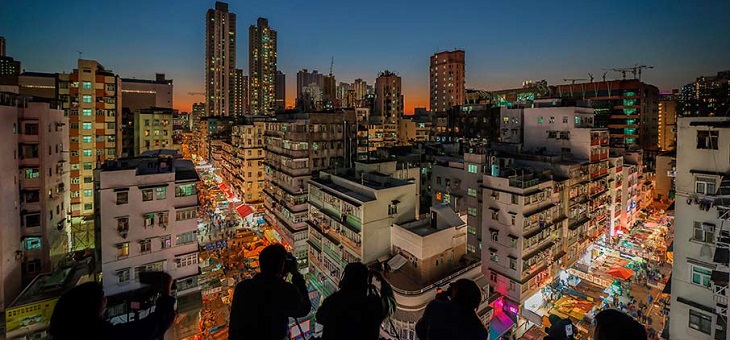Craig Tansley walks you through Hong Kong’s neighbourhoods and uncovers the city’s best-kept secret, Sham Shui Po …
•••
The neighbourhood of Sham Shui Po was so far off the Hong Kong tourist trail that the only travellers who had heard of it were those who had relatives there. While you’ll find some of the world’s most expensive real estate barely 30 minutes away on Hong Kong Island in Central, Sham Shui Po is best known for being home to the city’s first public housing estates.
But things are changing in Hong Kong. Visitors want grit … and nowhere is grittier than Sham Shui Po.
“This is Hong Kong to me,” local fashion designer Douglas Young says. “The real architecture of Hong Kong is not designed by architects. It’s designed by residents; it’s their laundry, their TV aerials, their signage, their graffiti. It provides us with that special layer.”
For this is one of Hong Kong’s most vibrant neighbourhoods. If you’re a fan of bustling local markets – Sham Shui Po’s your place. If you’re looking for electronics, the open-air Apliu Street markets are the city’s gold mine; while the flea markets in a district long known for clothing merchandise makes you feel like you’re in an Asian ‘take’ on London’s Soho district.
Behind the clothing merchants on Sham Shui Po’s main streets, there are laneways leading to new artistic hubs. At Wontonmeen, there’s a shared living space that’s home to 11 storeys of artists, journalists, musicians and designers; and at new cafes such as Openground, young locals share work desks while sipping imported coffee.
At the oldest public housing complex in the whole city – Shek Kip Mei Public Housing Estate – you’ll now find a contemporary museum, Mei Ho House Museum, offering a fascinating insight into the real Hong Kong, well beyond the bright lights and neon signs.
Around here, you’ll experience a lot more old-world China than colonial Britain, including Chinese teahouses on street corners. Drop into The Heritage Teahouse, located inside a former factory building that’s been transformed into a stunning arts centre (The Jockey Club Creative Arts Centre). That’s what this suburb is all about – the treasure between dangling electrical cables and garish street signage.
A warning: expect the understated. There are over 60 Michelin-starred restaurants in Hong Kong, but Sham Shui Po’s contribution is in an old apartment block – it’s one of the world’s cheapest Michelin-starred restaurant – Tim Ho Wan – on Fuk Wing Street. If you’re a pork bun lover, Tim Ho Wan will tantalise your taste buds.
Finish lunch off around the corner with a sweet tofu pudding at one of the city’s best traditional bean curd restaurants – Kung Wo Beancurd Factory – run by a former investment banker.
Other neighbourhoods worth a visit
Sheung Wan
It’s one of Hong Kong Island’s oldest neighbourhoods – on the site of the first British occupation of the city. These days, however, Sheung Wan is home to as many odd Chinese medicine shops and markets as there are stunning examples of Edwardian architecture. It’s now become Hong Kong’s trendiest neighbourhood, home to its most bohemian bars and cafes, but don’t go past Dried Seafood Street if you want to see the quirky side of Hong Kong. The city’s oldest food markets and antique shops are on Antique Street – seeing a pattern yet? – and are some of the city’s finest.
Tsim Sha Tsui
Located on the other side of Victoria Harbour, in Kowloon, Tsim Sha Tsui is a little more accessible than Central. With its sprawling parks and colonial monuments you can walk around sightseeing for hours.
Here, people-watching is highly recommended; for this is Hong Kong’s most ethnically diverse neighbourhood. You also won’t find better food anywhere in Hong Kong – there’s everything here from cheap noodle shops to Michelin-starred gourmet hotspots, and, of course, The Peninsula, one of Asia’s most iconic luxury hotels. Even if you don’t stay there, try its famous Day Spa or high tea.
Wan Chai
Wan Chai is the cultural hub of Hong Kong. Should you be looking for a beer or wine, Lockhart Road is Hong Kong’s premier bar district. The restaurants along Jaffe Road are some of Hong Kong’s finest – though for cheaper treats and to eat like a local, try the open-air dai pai dong restaurants in huge tents that are the neighbourhood’s calling cards. Look out for food festivals at the Convention and Exhibition Centre. If theatre’s your thing, head to the Hong Kong Academy for Performing Arts. The best art exhibitions in Hong Kong are at Wan Chai’s Hong Kong Arts Centre.
Yau Ma Tei
Most visitors may not venture to Yau Ma Tei because it is not as wellknown as its neighbours Tsim Sha Tsui and Mong Kok. But, Yau Ma Tei has Hong Kong’s most iconic street markets and some of the oldest restaurants – so the streets are literally buzzing with energy. There are amazing culinary treats all over – you’ll have to queue with ‘in-the-know’ locals at eateries like Four Seasons Pot Rice, but it’s worth the wait. Colonial architecture is everywhere, but it’s the markets you should come for. The Jade Market sells every type of jade jewellery you could ever think of, Shanghai Street is the chef’s pick for homewares, while the Temple Street Night Market is the city’s most famous.
More
Craig Tansley is a travel writer based on the Gold Coast. He writes for Australia’s major newspapers, as well as international titles such as the Sunday Times of London and Conde Nast Traveller in the US and the UK.
Download your free guide to planning your Hong Kong holiday. Or, if you’d like a printed copy packaged and posted to your mailbox, simply fill out this online form and we’ll send it to you!
Related articles:
Hong Kong missed by guidebooks
From street food to fine dining
The great outdoors

